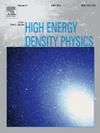Exploring hybrid scalar factor and ekpyrotic bouncing cosmology in f(Q,R) Gravity
IF 0.9
3区 物理与天体物理
Q3 PHYSICS, FLUIDS & PLASMAS
引用次数: 0
Abstract
In this study, we delve into the evolution of the Hubble parameter, focusing on its sign reversal in the early universe and its stability within gravity. Methods are employed to investigate the universe’s behavior concerning hybrid scale factor scenarios, including the sub-relativistic, radiation, ultra-relativistic, dust, and stiff fluid universes, concerning the equation of state (EoS) parameters. This research builds on previous ones by providing a more in-depth investigation of the bouncing scenarios inside the gravity framework, reconstructing gravitational Lagrangians established for certain parameter values. Once rebuilt, these Lagrangians allow the examination of energy conditions required for a realistic bouncing model and give analytical answers to the ekpyrotic (Ekkart) bounce model. The function of exotic matter, renowned for its high negative pressure, is the key factor promoting the universe’s acceleration expansion. An analysis of gravity theories, particularly focusing on bouncing scenarios, distinguishes this work from earlier studies on alternative gravity theories and their cosmological implications. This research offers a detailed investigation of bouncing models along with a detailed examination of the energy conditions present in gravity.
探索f(Q,R)引力中的混合标量因子和热弹跳宇宙学
在这项研究中,我们深入研究了哈勃参数的演变,重点关注它在早期宇宙中的符号反转及其在f(Q,R)重力下的稳定性。采用不同的方法研究了亚相对论、辐射、超相对论、尘埃和硬流体宇宙等混合尺度因子场景下的宇宙行为与状态方程参数的关系。本研究建立在先前研究的基础上,对f(Q,R)引力框架内的弹跳情况进行了更深入的研究,重建了为某些参数值建立的引力拉格朗日量。一旦重建,这些拉格朗日量允许检查一个现实的弹跳模型所需的能量条件,并给出了解析答案的Ekkart弹跳模型。奇异物质的功能以其高负压而闻名,是促进宇宙加速膨胀的关键因素。对f(Q,R)引力理论的分析,特别是对弹跳情景的分析,将这项工作与早期关于替代引力理论及其宇宙学含义的研究区分开来。本研究对弹跳模型进行了详细的研究,并对f(Q,R)重力中存在的能量条件进行了详细的检查。
本文章由计算机程序翻译,如有差异,请以英文原文为准。
求助全文
约1分钟内获得全文
求助全文
来源期刊

High Energy Density Physics
PHYSICS, FLUIDS & PLASMAS-
CiteScore
4.20
自引率
6.20%
发文量
13
审稿时长
6-12 weeks
期刊介绍:
High Energy Density Physics is an international journal covering original experimental and related theoretical work studying the physics of matter and radiation under extreme conditions. ''High energy density'' is understood to be an energy density exceeding about 1011 J/m3. The editors and the publisher are committed to provide this fast-growing community with a dedicated high quality channel to distribute their original findings.
Papers suitable for publication in this journal cover topics in both the warm and hot dense matter regimes, such as laboratory studies relevant to non-LTE kinetics at extreme conditions, planetary interiors, astrophysical phenomena, inertial fusion and includes studies of, for example, material properties and both stable and unstable hydrodynamics. Developments in associated theoretical areas, for example the modelling of strongly coupled, partially degenerate and relativistic plasmas, are also covered.
 求助内容:
求助内容: 应助结果提醒方式:
应助结果提醒方式:


